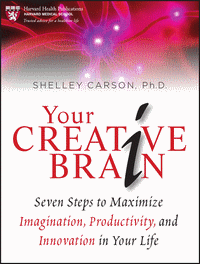by Shelley Carson, PhD
 Both highly creative individuals and ADHD-diagnosed individuals often report feeling out of place, like a square peg in a round hole.
Both highly creative individuals and ADHD-diagnosed individuals often report feeling out of place, like a square peg in a round hole.
(In fact, in my creativity research questionnaires I actually ask the question “Do you often feel like a square peg in a round hole?” Participants who score high on the Creative Achievement Questionnaire have answered “yes” significantly more often than those who have low scores in creative achievement.) One of the reasons that both creative and ADHD persons feel “different” is that their attentional patterns often deviate from what we consider to be the norm, leading to an assortment of problematic results.
Whether in the classroom or the boardroom, both creative (C) and ADHD (AD) individuals are often disruptive. They may veer off task, interrupt frequently, ask inappropriate questions, appear moody or demanding, and derail the flow of progress. Cognitively, both AD’s and C’s may demonstrate distractibility, inattentiveness, lack of sustained attention, novelty-seeking and sensation-seeking, and appear to be academic underachievers.
These similarities form the basis of the “creative-upside-of-ADHD” theory that has been promoted in several recent books. These books claim that many highly creative luminaries from Edison to Einstein were actually suffering from ADHD, and they hypothesize that parents who have an ADHD-diagnosed child may actually be harboring a creative genius.
We now have several empirical studies that have tested this theory, and the results are somewhat inconclusive. Most empirical studies have found that a larger than expected subset of ADHD individuals score above the mean on divergent thinking tests (a commonly-used measure of creative thinking ability). Several studies have also found that a subset of creatively gifted individuals qualify for an ADHD diagnosis. So what does this mean? Are ADHD children possible creative geniuses?
The results of these studies make sense if we consider that creativity and ADHD may share some common genetic vulnerabilities which mediate underlying deviations in attention. These shared vulnerabilities may be expressed as either creative ability or a cognitive disorder (or both), depending upon the presence or absence of other cognitive strengths or deficits. In other words, deviations in normal attentional patterns may have an upside in enhanced creativity – but only in specific cases.
Research in our lab, for example, indicates that when distractibility (a symptom of both C and AD) is combined with cognitive strengths such as high IQ or high working memory capacity, the individual may be able to make rich and creative connections between the distracting elements and information already stored in the brain. The theory here is that distractibility allows additional information into conscious awareness that would normally be filtered out, and high IQ allows that information to be manipulated and combined in novel and creative ways. However, if distractibility is combined with cognitive liabilities, such as lower IQ or working memory deficits, the result may be classic ADHD symptoms in which the individual does not have the ability to process the additional information available to conscious awareness.
The problem with misdiagnosing the creative child as ADHD is that the creative child uses deviations in attention, such as distractibility, as a tool for creative thinking. However, the standard treatments for ADHD focus on reducing the impact of distractibility and attentional deviations. For example, educational accommodations typically prescribed for the ADHD include breaking complex assignments into smaller pieces, reducing distractions, and providing more structured educational supervision. Because the creative brain craves novelty and complexity, these interventions may do more harm than good for the creative child.
The possibility of misdiagnosis suggests that some sort of creativity testing should be included in diagnostic battery for ADHD (especially when a child has demonstrated high IQ or other cognitive strengths). However, a subset of highly creative children may also qualify for ADHD diagnosis because of their level of dysfunction in either academic or social realms. Therefore, high scores on creativity testing won’t necessarily rule out a diagnosis but will merely inform the treatment options. (Note that there is currently little evidence that the misdiagnosed creative child will suffer from the administration of pharmaceuticals such as methylphenidate other than the known side effects).
Both true ADHD and misdiagnosed creative children will benefit from a creativity-stimulating environment. Parents can provide such an environment by exposing the child to creative work early in life, rewarding intellectual curiosity, and paying attention to creative activities (drawing, music, word games) in which a child shows sustained interest. Parents who engage in creative activities themselves will also model creative behavior. Regardless of whether the child is creative or AD, he or she will benefit from the enhancement of cognitive strengths associated with creativity.
Shelley Carson is a Harvard psychologist and author of Your Creative Brain: Seven Steps to Maximize Imagination, Productivity and Innovation in Your Life, published by Jossey-Bass/Wiley.
Submit a guest post and be heard.










![AI's role in simplifying communication [PODCAST]](https://www.kevinmd.com/wp-content/uploads/AIs-role-in-simplifying-communication-190x100.jpg)


![Embracing imperfection: strategies for growth and self-compassion [PODCAST]](https://www.kevinmd.com/wp-content/uploads/Embracing-imperfection-strategies-for-growth-and-self-compassion-190x100.jpg)
